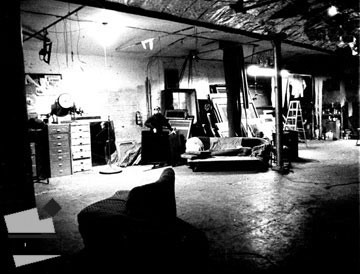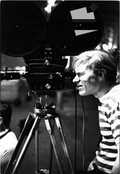Surface Tension...Reflections On Warhol
 by Charles Borkhuis, poet
by Charles Borkhuis, poet
Despite Andy Warhol’s monotone preference for being a machine, which certainly had its hypnotic and terrifying aspects, there was also something playful, even Zen-like about his studied blank stare.
To listen to him tell it, there was nothing behind that opaque surface, but this was part of the ironic paradox of his created persona and not to be taken literally. By filling us up with more and more reproductions of the Real, Warhol was actually emptying us out, but in a typically Western, additive way. As a meditation on Nothing, his art invited our cultural excesses to cancel themselves out: more is more than more -- it’s less.
He favored making more channels and more information available to more people, partly because he wanted to show that increased choices numb our ability to differentiate between them. We’re free to say anything we want, but everything we say means less and less. In a culture in which everything from presidents to toothpaste is sold to us in the same way, meaning plays third fiddle to the delivery system. Andy didn’t really want to make more choices; he wanted to let the machine make the choices for him.
In Warhol’s world, there is a flattening out of all values; everything and everyone has become replaceable; nothing is for real, or for keeps. Everyone is allowed his 15 minutes of fame, but then he has to give up the mike to the next wannabe. If Warhol told us there was nothing behind his surface, he was doing it with a wink towards posterity. But, of course, he wouldn’t be caught dead winking. We would have hated him for it if he had. Far from being cynical, Andy was open and enthusiastic about the cultural changes happening around him. Although some criticized him for being apolitical, taking sides was not his way. He was ontologically disengaged. The strength of his vision was not in changing the world so much as seeing it clearly as it is, and in his fragile, dandyish way, he did that better than any artist of his time. Even his detractors had to admire the purity and consistency of his life-performance. He was capable, as few are, of playing out his philosophy to the bitter end. Fast on the reversal switch, Andy refused to make art his life; he made his life his art.
He coyly avoided being food for the intellectual feeding frenzy that is critical theory. Yet if he was anything, he was an idea man. He gave pop culture images back to us as if they were masterpieces, and indeed they now appear as our classics. But he did it with a kind of casual, throwaway flippancy that took the air out of his own balloon before anyone else did. It was impossible to argue with him. You can’t argue with a cipher. Part cagey minimalist, part discrete sage, he provoked the viewer into doing the hard work of arguing with himself. He pointed to who we are, what we value, and where we are headed, but refused to interpret for us.
In contrast to the previous generation of abstract expressionists, who saw themselves as making agonizing, existential decisions about their art, he suggested that artists were no different than anyone else; we’re all commodities for sale in a consumer society. And we’re becoming more so. Individuals were not interesting to Warhol; what was interesting was their “star quality,” their capacity to make others want to watch them. The subjects of his silkscreen portraits were often caught in all their gaudy, over-exposed, hyper-reality, and he made them pay. But how could he do otherwise when people had already made themselves into items for sale? His infamous statement, “Business is the best art,” was a slap in the face to those who thought that there was still some point in distinguishing the art object from the packaged commodity. Warhol had clearly observed that ideas about individuality and originality had run out of gas, and that the mass-produced object was fast on the way to replacing us. Our subjectivity was disappearing, and we were complicitous consumers in this commercial, body-snatching operation.
The images he gave us were under our noses: the soup can, the cow, the superstar, the shoe, yet as Duchamp had realized: Hang a shovel in an art gallery, and it’s no longer just a shovel. Objects are colored by a certain intensionality, which we place over them. But Marcel made one of a kind, whereas the Andy-machine made many of the same.
Warhol’s genius was wrapped up in the simple, unpretentious way in which he told a radical truth about pop culture -- so simple, in fact, that it was hard to believe what he was saying. Whatever he said was always too much and he knew it. Words were simply placeholders for silence. His dazzling, brief statements had the discriminating crystallizations of poetry, and in this sense, he was a visionary minimalist, not unlike the Haiku masters.
A lifelong Catholic, Andy was always religious, even strangely erotic in the way that saints, in their extreme vulnerability, are eroticized by a nearness to death. Warhol was an icon of twentieth-century art, and icons don’t talk much. They pose in bas-relief, inviting crowds to circle in awe and fascination, and in this regard, they are not dissimilar to the famous, captured in the halo of a flash photo. Neither religious icon nor pop idol has a real identity; both have defaulted to a ceremonial pose, so stone and photo becomes them. Neither words nor events can touch them because they inhabit the sanctity of the artificial, the solitude of the beyond. They are nothing like us; instead, we have made them into stars flashing in the firmament, yet we remain guided by them, in order to venerate and worship that which we could never attain.
After he was shot and almost died, Andy became more ghostly, more ethereal, perhaps in a sense, a reproduction of a reproduction, posing the question of whether he was ever truly alive. Even his silver-dyed hair, chosen years before nature would intervene, may have served as an early talisman against aging. Death couldn’t really reach him because in an important sense, he had already died. Warhol was our bad mirror; he bounced our reverse image back at us without exaggeration or comment. If we were absorbed in a frantic youth culture that tried at all costs to keep death at bay, he would show us how to do it better. Swallow a bit of death each day and your image will never grow old.
Perhaps Andy never quite crawled out from under the shadow of the crucifix: he took our sins upon himself and sacrificed his life for us, over and over. Like the saints, Warhol chose to keep silent and let others speak for him. He carried a tape recorder around to restaurants and clubs and started the now infamous “Interview” magazine and then stepped away from it, just as he had stepped away from his underground films and let the machine keep rolling without him. He wanted to be replaced, to disappear inside his creations. Seemingly he had nothing to say, but paradoxically, he had more to tell us about ourselves, and our ghostly, virtual future than any artist in the second half of the twentieth-century.
* * * * *
Charles Borkhuis is a poet, playwright, and critic. His plays have been
produced in New York City, Los Angeles, San Francisco, and Hartford.
His radio play The Sound of Fear Clapping was aired over WNYC
radio and nominated for a Peabody Award. Some of his produced plays
include: Phantom Limbs, Bruises, Nothing to Declare, The Accident, Destinations, Sunspots,
Hamlet’s Ghosts Perform Hamlet, Magnetic North, and Surface Tension. He is a recipient
of a Dramalogue Award in playwriting and the former editor of Theater:Ex magazine, an
experimental theater/performance publication. He recently completed a full-length filmscript
entitled Undercurrent.
His three collections of poems are: Dinner with Franz (Poetry New York, 1998), Proximity
(Stolen Arrows) (Sink, 1995), and Hypnogogic Sonnets (Red Dust, 1992). A new book of his
poems Alpha Ruins (Bucknell University) is forthcoming in 2000. His poetry has been anthologized
in: Writing from the New Coast: Technique & Practice (o.blek), Primary Trouble (Talisman House),
The Gertrude Stein Awards In Innovative Poetry - 1995-96 (Sun & Moon), and the Avec Sampler -
1998 (Avec). Several of his essays on contemporary poetry are forthcoming in 2000 in two books
published by the University of Alabama: Post-Language Poetries and We Who ‘Love to Be
Astonished’ (innovative women’s poetry).
Mr. Borkhuis lives and writes in New York City.

 Post a Comment
Post a Comment
Reader Comments